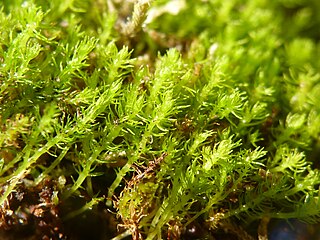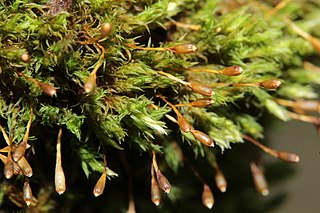Related Research Articles

Takakia is a genus of two species of mosses known from western North America and central and eastern Asia. The genus is placed as a separate family, order and class among the mosses. It has had a history of uncertain placement, but the discovery of sporophytes clearly of the moss-type firmly supports placement with the mosses.

Sphagnopsida is a class of mosses that includes a single subclass Sphagnidae, with two orders. The order Sphagnales contains four living genera: Sphagnum, with all but three of the species, and Ambuchanania, Eosphagnum, and Flatbergium, each with a single species. The Protosphagnales contains a single fossil species.
Aschisma kansanum is a species of moss in the family Pottiaceae. It is endemic to the United States. Its natural habitat is temperate grassland. It is threatened by habitat loss.

Calymperastrum latifolium is the sole species in the monotypic moss genus Calymperastrum. It is a poorly known moss, having been collected only three times. All three collections were from the trunks of Macrozamia, in the Southwest Botanic Province of Western Australia. It is presumed endemic to the region, making it the only moss genus known endemic to that state.
Ilma Grace Stone, née Balfe, was an Australian botanist who specialised in bryology. She was an author, collector, and researcher of Australian mosses, a subject on which she lectured and wrote.

The Pottiaceae are a family of mosses. They form the most numerous moss family known, containing nearly 1500 species or more than 10% of the 10,000 to 15,000 moss species known.

Ptychomitrium is a widespread genus of mosses found in many parts of the world.

The Botany of Lord Auckland's Group and Campbell's Island is a description of the plants discovered in those islands during the Ross expedition written by Joseph Dalton Hooker and published by Reeve Brothers in London between 1844 and 1845. Hooker sailed on HMS Erebus as assistant surgeon. It was the first in a series of four Floras in the Flora Antarctica, the others being the Botany of Fuegia, the Falklands, Kerguelen's Land, Etc. (1845–1847), the Flora Novae-Zelandiae (1851–1853), and the Flora Tasmaniae (1853–1859). They were "splendidly" illustrated by Walter Hood Fitch.

Pleurophascum grandiglobum is a moss endemic to Tasmania, Australia, and was first noted by S. O. Lindberg in 1875 for its peculiar form of cleistocarpous capsule, erect growth form, lateral perichaetia, and ecostate leaves. Its exceedingly large, inoperculate, and often brightly coloured capsules captured the heart of the 19th-century Scandinavian bryologist, who considered the moss to be "of no less interest to the Museologist than is Rafflesia or Welwitschia to the Phanerogamist". The species currently belongs to a monogeneric family Pleurophascaceae that is found only in temperate Australasia and includes three different species. Pleurophascum ovalifolium, heretofore known as P. grandiglobum var. decurrens, is the New Zealand taxon while the last remaining member of the genus, Pleurophascum occidentale, occurs only in Western Australia.

Tortula is a genus of mosses in the family Pottiaceae.

Ulota is a genus of mosses comprising 69 species with a worldwide distribution, though most species are found in the southern hemisphere.

Tortula muralis, commonly known as wall screw-moss, is a species of moss in the family Pottiaceae. T. muralis is found throughout the world.
Timmiellaceae is a family of haplolepideous mosses (Dicranidae). It contains two genera, Luisierella and Timmiella, that were formerly place in family Pottiaceae.
Micromitrium is a genus of haplolepideous mosses (Dicranidae) in the monotypic family Micromitriaceae . The genus Micrometrium was previously placed in family Pottiaceae in order Pottiales.

Fabroniaceae is a family of mosses belonging to the order Hypnales. It has a worldwide distribution, in temperate and tropical regions.
References
- 1 2 3 4 Stoneburner, Ann; Wyatt, Robert; Catcheside, David & Stone, Ilma (1993). "Census of the Mosses of Western Australia". The Bryologist. The Bryologist, Vol. 96, No. 1. 96 (1): 86–101. doi:10.2307/3243324. JSTOR 3243324.
- ↑ Buck, William R. & Bernard Goffinet. 2000. "Morphology and classification of mosses", pages 71-123 in A. Jonathan Shaw & Bernard Goffinet (Eds.), Bryophyte Biology. (Cambridge: Cambridge University Press). ISBN 0-521-66097-1.
- ↑ Zander, R. H. (1989). "Seven new genera in Pottiaceae (Musci) and a lectotype for Syntrichia". Phytologia. 65: 424–436.
- ↑ Zander, R. H. (1993). "Genera of the Pottiaceae: Mosses of harsh environments". Bulletin of the Buffalo Society of Natural Sciences. 32: 1–378.
- ↑ Griffin III, Dana & William R. Buck. 1989. Taxonomic and Phylogenetic Studies on the Bartramiaceae. The Bryologist92 (3): 368-380.